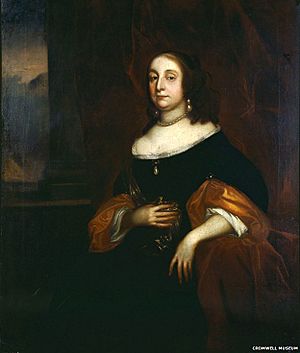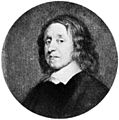Elizabeth Cromwell facts for kids
Quick facts for kids
Elizabeth Cromwell
|
|
|---|---|

Portrait of Elizabeth Cromwell painted by Robert Walker
|
|
| Born |
Elizabeth Bourchier
1598 Felsted, Essex, Kingdom of England
|
| Died | November 1665 (aged 66–67) Northborough, Northamptonshire, Kingdom of England
|
| Spouse(s) | |
| Children | Robert Cromwell Oliver Cromwell Bridget Cromwell Richard Cromwell Henry Cromwell Elizabeth Cromwell James Cromwell Mary Cromwell Frances Cromwell |
| Parent(s) | Sir James Bourchier Frances Crane |
Elizabeth Cromwell (born Elizabeth Bourchier; 1598 – 1665) was an important figure in English history. She was the wife of Oliver Cromwell, who became the powerful leader known as the Lord Protector of England, Scotland, and Ireland. Elizabeth was also the mother of Richard Cromwell, who later became the second Lord Protector.
Contents
Early Life and Marriage
Elizabeth Bourchier was born in 1598. Her father was Sir James Bourchier, a wealthy merchant from Felsted in Essex. Her mother was Frances Crane. Elizabeth was the oldest of twelve children in her family.
On August 22, 1620, Elizabeth married Oliver Cromwell in London. Their wedding took place at St Giles, Cripplegate church.
Oliver Cromwell often wrote loving letters to Elizabeth when he was away fighting in wars. Some of these letters were even published later in a collection of love letters. Elizabeth and Oliver had nine children together. Eight of their children grew up to be adults.
During her husband's time as a leader, some people spread false rumors about Elizabeth. They tried to make her look bad, but these untrue stories did not cause any harm.
Elizabeth was even introduced to King Charles I when he was a prisoner at Hampton Court. She was still on good terms with her husband at the time.
As Lady Protectress (1653–1658)
In December 1653, Oliver Cromwell was named the Lord Protector. This made Elizabeth the "Lady Protectress." She was given the title Her Highness.
Some historians believe Elizabeth was not very comfortable with her new role. She seemed to prefer managing her home and family. She tried to stay out of public politics. However, she was still sometimes criticized by people who did not like her husband's rule.
One writer, James Heath, said that Elizabeth was very careful with money. She managed her household well. Another book, called The Court and Kitchen of Mrs. Joan Cromwell, complained that Elizabeth was too thrifty.
However, other people had different views. Edmund Ludlow, who knew Elizabeth personally, said she was not happy about moving into the royal palace. She did not seem to enjoy the fancy new home.
Some people thought Elizabeth had influence over her husband. They even accused her of helping to decide who got military jobs. But others, like John Heneage Jesse, believed she mostly focused on her family life. Jesse also said there is no real proof that she had any political power over Oliver. He even suggested that Elizabeth tried to convince her husband to bring back the young King, Charles II, but she was not successful.
Only one letter written by Elizabeth is believed to still exist. It is a loving letter to her husband, the Protector.
Elizabeth also supported six daughters of clergymen. She employed them to do needlework in her rooms.
Later Years (1658–1665)
After Oliver Cromwell died in 1658, and her son Richard stepped down in 1659, the Cromwell family lost their power. However, the army made sure Elizabeth received enough money to live comfortably.
When the monarchy was brought back in 1660, Elizabeth planned to leave England. She gathered many valuable items to take with her. When the government found out, they ordered a search. They found and took back several items that belonged to the royal family.
Elizabeth later moved to the home of her son-in-law, John Claypole. This was in Northborough, Northamptonshire. She lived there until she died in November 1665. She was buried in Northborough church on November 19.
Children
Elizabeth died in 1665. Five of her nine children were still alive, along with many grandchildren.
- Robert Cromwell (1621–1639): He died while he was away at school.
- Oliver Cromwell (1623–1644): He became a soldier and died from smallpox.
- Bridget Cromwell (1624–1681): She married twice and had four children.
- Richard Cromwell (1626–1712): He became Lord Protector after his father, but only for one year. He had nine children.
- Henry Cromwell (1628–1674): He served as the Lord Deputy of Ireland. He had seven children.
- Elizabeth Cromwell (1629–1658): She was known as "Bettie" and was said to be her father's favorite child. She had four children.
- James Cromwell (1632): He was born and died in the same year.
- Mary Cromwell (1637–1713): She married Thomas Belasyse, the first Earl Fauconberg.
- Frances Cromwell (1638–1721): She married twice.
Cultural Depictions
During her lifetime, Elizabeth was sometimes shown in funny or critical writings. One play from 1661, The Cutter of Colman Street, made fun of her. It suggested she was not very generous.
A small portrait of Elizabeth was painted by Samuel Cooper. He described her as "neither uncomely or undignified in person."
Elizabeth Cromwell is also a character in a play from 1681 called The Roundheads or, The Good Old Cause.
In 1840, the painter William Fisk created a painting. It showed Elizabeth and her children supposedly asking Oliver Cromwell to save the King's life.
In the 1970 film Cromwell, Elizabeth Cromwell was played by Zena Walker.
Portrait gallery
Sources
Attribution: ![]() This article incorporates text from a work in the public domain: "Memoirs of the court of England, from the revolution in 1688 to the death of George the Second" by John Heneage Jesse (1846)
This article incorporates text from a work in the public domain: "Memoirs of the court of England, from the revolution in 1688 to the death of George the Second" by John Heneage Jesse (1846)




